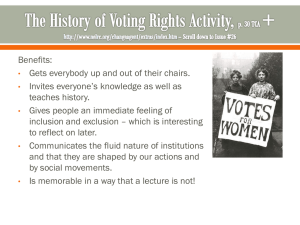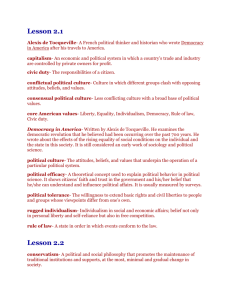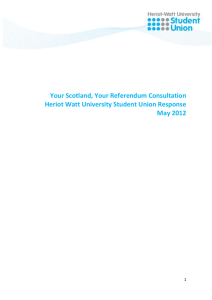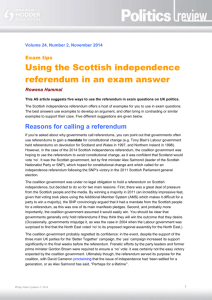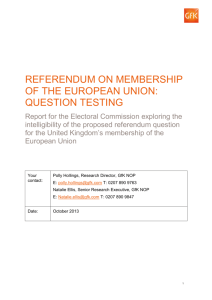this one is to Edinburgh
advertisement
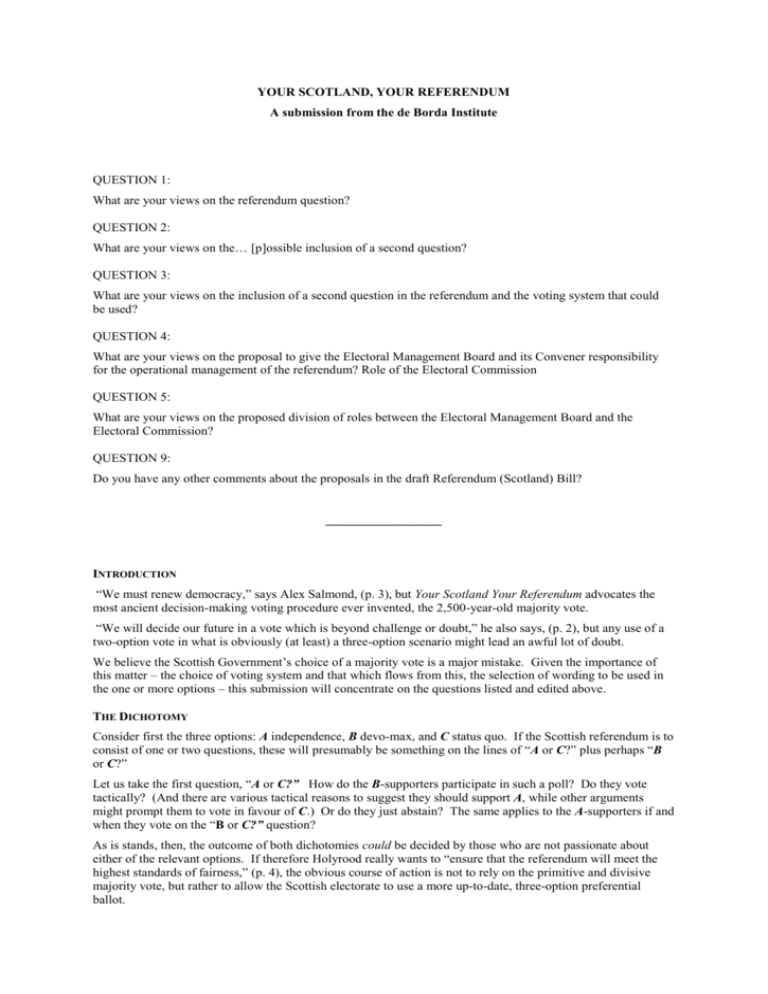
YOUR SCOTLAND, YOUR REFERENDUM A submission from the de Borda Institute QUESTION 1: What are your views on the referendum question? QUESTION 2: What are your views on the… [p]ossible inclusion of a second question? QUESTION 3: What are your views on the inclusion of a second question in the referendum and the voting system that could be used? QUESTION 4: What are your views on the proposal to give the Electoral Management Board and its Convener responsibility for the operational management of the referendum? Role of the Electoral Commission QUESTION 5: What are your views on the proposed division of roles between the Electoral Management Board and the Electoral Commission? QUESTION 9: Do you have any other comments about the proposals in the draft Referendum (Scotland) Bill? __________________ INTRODUCTION “We must renew democracy,” says Alex Salmond, (p. 3), but Your Scotland Your Referendum advocates the most ancient decision-making voting procedure ever invented, the 2,500-year-old majority vote. “We will decide our future in a vote which is beyond challenge or doubt,” he also says, (p. 2), but any use of a two-option vote in what is obviously (at least) a three-option scenario might lead an awful lot of doubt. We believe the Scottish Government’s choice of a majority vote is a major mistake. Given the importance of this matter – the choice of voting system and that which flows from this, the selection of wording to be used in the one or more options – this submission will concentrate on the questions listed and edited above. THE DICHOTOMY Consider first the three options: A independence, B devo-max, and C status quo. If the Scottish referendum is to consist of one or two questions, these will presumably be something on the lines of “A or C?” plus perhaps “B or C?” Let us take the first question, “A or C?” How do the B-supporters participate in such a poll? Do they vote tactically? (And there are various tactical reasons to suggest they should support A, while other arguments might prompt them to vote in favour of C.) Or do they just abstain? The same applies to the A-supporters if and when they vote on the “B or C?” question? As is stands, then, the outcome of both dichotomies could be decided by those who are not passionate about either of the relevant options. If therefore Holyrood really wants to “ensure that the referendum will meet the highest standards of fairness,” (p. 4), the obvious course of action is not to rely on the primitive and divisive majority vote, but rather to allow the Scottish electorate to use a more up-to-date, three-option preferential ballot. PRECEDENTS Many countries have enjoyed multi-option (albeit single-preference) referendums – in 1992, New Zealand had a ballot on electoral reform in which there were five options. In 1982, Guam resolved the question of its constitutional future in a six-option poll. And by happy precedent, a three-option constitutional vote took place in 1948 in Nova Scotia. Initially, the British Government suggested that the people of Nova Scotia should have a two-option question. Many of them, however, disagreed because they wanted a third option, and the good people of Halifax made their opinions clear. As a result, a three-option ballot was held instead, under the tworound system, (TRS). The consequent level of participation was high: an 88% turnout was achieved in both rounds, with figures of 14%, 41% and 45% for the three options – let us call them X, Y and Z – in the first round, and 48% and 52% in the second, between Y and Z. To all concerned, it is probably correct to say that the methodology was considered to be both “fair” and “decisive”.1 The only mention you make of multi-option voting was inaccurate. New Zealand did not have a “two-question referendum” in 1993 if by that term you mean two majority votes… and given the context and the tone of the rest of the paper, such is obviously the implication, (p. 15n). To be fair, you do say “the second gave a choice of alternative systems” but that also implies a binary process. So now to your questions. QUESTIONS 1, 2 AND 3, AS EDITED ABOVE Our views on the voting system are that it should be discussed! When there are three options ‘on the table’, there are various ways of voting. They include the following: i) two majority votes ii) plurality voting iii) two-round voting (TRS) iv) serial voting v) approval voting vi) the alternative (or single transferable) vote (AV and STV) vii) a Borda count (BC) viii) a modified Borda Count (MBC) ix) the Condorcet rule. Of the above, some allow the voter to express their viewpoint to the full, others are more restrictive; some are accurate, others can be capricious if not indeed inaccurate; some facilitate the voter to cast a sincere ranking, others encourage tactical voting; and while nothing is perfect, some are excellent, others good and a few distinctly bad. The choice of voting system is crucial! Not least for the sake of transparency, the voters must know how the ballots are to be counted; furthermore, they are entitled to know why the Scottish Government wants to use an antiquated methodology, when other more democratic procedures are available. Your paper makes hardly a mention. And yet, in earlier times, the SNP was adamant: “Only a multi-option referendum allows the people – and not Westminster – to answer the ‘Scottish question’. 2 QUESTIONS 4 AND 5, AS EDITED ABOVE In our dealings with the Electoral Commission, both the Edinburgh and London offices have been extremely reluctant to discuss even the possibility of different multi-option voting systems. (Even in the divided society of Northern Ireland, the same sadly applies to their Belfast colleagues.) Last year’s UK referendum on the voting system was an obvious instance of where the subject under debate was multi-optional; yet the Commission was prepared to go along with a referendum in which the electorate was given a choice, in effect, of either David Cameron’s first preference or David Cameron’s second preference. Those who might have wanted to vote for PR-list, or MMP, or PR-STV etc, could be forgiven for feeling disenfranchised. We do not therefore have confidence in the Electoral Commission. (We have had no dealings with the Electoral Management Board.) For more information, see the SNP’s paper, A Multi-Option Referendum – let the People Decide, May 1992, p. 6. 1 2 Ibid, p 1. QUESTION 9 The prospect or use of a two-option plebiscite has been (not the but) a cause of violence if not war in the Balkans, the Caucasus, East Timor, Kashmir, Northern Ireland, Quebec, and now Sudan. Do we not have a moral responsibility towards our fellow citizens abroad? Should we not be at least consider those voting methodologies which are far more modern, far more fair, and far more inclusive than the old-fashioned (though admittedly ubiquitous) majority vote? Peter Emerson The de Borda Institute Belfast 26.1.2012 PS May we also point out that we have discussed multi-option preferential referendums in a number of Scottish ‘consultations’, and published a large amount of material on the subject – not least an article entitled The Next Scottish Referendum in Scottish Affairs, No 73, Autumn 2010. Peter Emerson The Director, the de Borda Institute 36 Ballysillan Road Belfast BT14 7QQ Northern Ireland 0044 (0)28 90711795 0044 (0)7837717979 www.deborda.org pemerson@deborda.org



